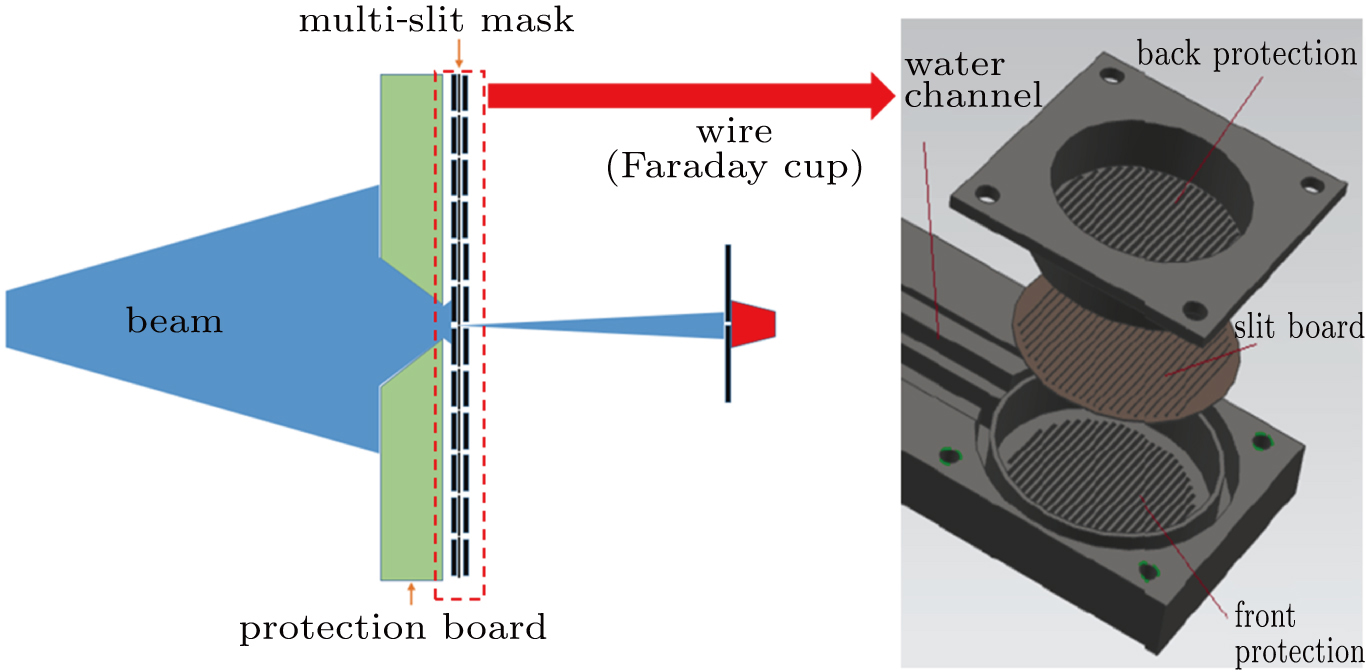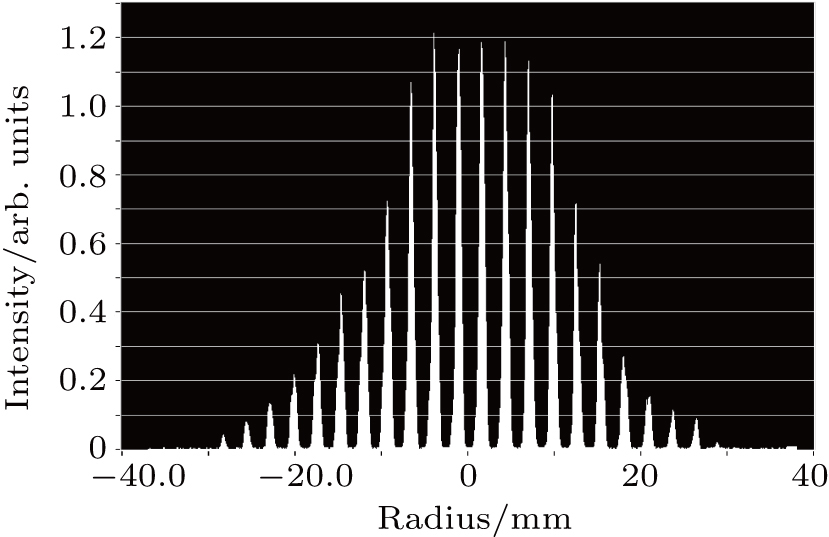† Corresponding author. E-mail:
Project supported by the National Basic Research Program of China (Grant No. 2014CB845502) and the National Natural Science Foundation of China (Grant No. 91126004).
A combined unit, which has the ability to measure the current and emittance of the high intensity direct current (DC) ion beam, is developed at Peking University (PKU). It is a multi-slit single-wire (MSSW)-type beam emittance meter combined with a water-cooled Faraday Cup, named high intensity beam emittance measurement unit-6 (HIBEMU-6). It takes about 15 seconds to complete one measurement of the beam current and its emittance. The emittance of a 50-mA@50-kV DC proton beam is measured.
As a member of the Chinese initiative accelerator driven system (CIADS) project, Peking University (PKU) is undertaking the R & D program on high current DC hydrogen ion source development.[1] To meet the requirements of the CIADS project, Peking University has improved the compact permanent magnet 2.45-GHz ECR ion source (PKU PMECRIS).[2] To measure the performance of PKU PMECRIS, Faraday cup and emittance meter for high intensity beam are needed.
There are many kinds of emittance meters for ion beam. For high-intensity direct current (DC) beam, the most common way to measure the emittance is the single slit sampling method, which is easy to arrange enough water-cooling. For example, the Allison scanner developed at the International Fusion Materials Irradiation Facility (IFMIF)[3] has a strong water-cooled slit, which is able to measure the 125-mA DC deuterons beam. Frankfurt University developed a single slit-grid emittance meter[4] to measure the high current DC proton beam, and the slit has a strong water-cooling just like that of the Allison scanner in IFMIF. However, the single slit sampling method has a low efficiency in beam sampling, which results in a long measurement time. For both the Allison scanner and single Silt-Grid emittance meter, they take more than 20 minutes to complete a measurement, which demands high stability of the beam. None of those emittance meters can measure the total beam current.
The multi-slit sampling method is much faster than the single slit sampling method, although the distance between slit and wire should well match with the beam divergence and the special period of slits. For example, several tens of seconds are enough to complete one measurement for multi-slit single-wire (MSSW)-type emittance meter developed in PKU.[5] Five sets of high intensity beam emittance measurement units (HIBEMUs) were developed at PKU to obtain a hundred-mA tens keV beam at lower duty factor(usually less than 10%). When the ion beam goes to the DC beam, damage appears within less than 1 hour because much more energy is deposited on the multi-slit mask than to the pulsed beam. To overcome this shortcoming, an MSSW-type emittance meter HIBEMU-6 has been designed at our laboratory, which has the ability to withstand several kilowatts beam heating. Several improvements and innovations make it able to measure the 50-mA@50-kV DC proton beam successfully. Also a high-power Faraday cup is combined with the emittance meter, so HIBEMU-6 can measure the current of high-intensity DC beam, too. The physical design, control process and measurement result of HIBEMU-6 will be presented in this paper.
The HIBEMU-6 design is based on the previous MSSW-type emittance meter HIBEMU-5,[6] but strong water-cooling and protection are adopted. The full beam impinges upon the multi-slit and is cut into several small beamlets. For the MSSW emittance meter, one wire (in fact a slit followed by a Faraday cup (FC)) scanning across all the beamlets, which is usually within 1 minute, is enough to arrive at the necessary position and obtain angle information. However, in order to avoid the collimation effect, which will cut the divergent beam and introduce measurement error, the multi-slit mask should not be thicker than 1 mm, which means that there is no space for water-cooling inside the slit board. The thermal design is the biggest challenge to the MSSW emittance meter to be used in high-intensity beam measurement, because the full beam power will be deposited on the multi-slit mask. Considering the fact that only one slit is used in measurement at one moment, the first protection way is to set a thick water-cooled board with a small window in front of the multi-slit mask to reduce the beam bombarding on the multi-slits mask (shown in Fig.
The HIBEMU-6 combines a total beam measurement Faraday cup with the MSSW-type emittance units. The main mechanical structure of HIBEMU-6 is shown in Fig.
The control system of the new emittance meter HIBEMU-6 is based on a relay controller. The relay controller is composed of tens of relays which constitutes a logical movement control system. Overview of the instrument is shown in Fig.
The DC proton beam beyond 50 mA with an energy of 50 keV extracted from the PKU 2.45-GHz microwave proton source has been run for 296 hours continuously without any break or spark.[7,8] The HIBEMU-6 has been installed on the ion source test bench and measured the emittance of this DC beam. Since the total charge of the extracted beamlet is quite small, the background and noise are sensitive to the emittance estimation. One of the useful approaches to dealing with background would be the “core emittance” estimation[9] to deduce the actual emittance. At first the obtained phase space distribution is treated as a threshold in order to remove a given fraction of the particles after the background subtraction. An average value of the background noise measured from the position without any beam is used for the background subtraction. The mean value of the first 300 data without signal is used as the threshold. And “Emittance Mode”[10] is used in the emittance treatment. To get rid of the high-frequency noise, fast Fourier transform (FFT) is used in the spectrum analysis. Several interpolation methods are used in the multi-slit sampling reconstruction. Main parameters of the diagram such as radius, maximum and minimum of position and angle as well as normalized root-mean-square (RMS) emittance can be read from the program interface. The measurement result shows that the 50-mA@50-kV DC proton beam has a low root mean square (RMS) emittance of 0.186 π · mm · mrad as shown in Fig.
The new emittance meter HIBEMU-6 developed at PKU is used to measure the 50-mA@50-kV DC proton beam successfully. It demonstrates that the 50-mA@50-kV DC proton beam has an acceptable emittance for most accelerators. The HIBEMU-6 is a practical and convenient device, which is able to measure the emittance as well as the total current of the high intensity DC beam. It has a fast measurement process, which only takes about 15 seconds for one scanning. In general, HIBEMU-6 makes heat-resistance reliable and realizes the fast measurement.
| [1] | |
| [2] | |
| [3] | |
| [4] | |
| [5] | |
| [6] | |
| [7] | |
| [8] | |
| [9] | |
| [10] |






